PREVIOUS
SDG Goal wise programs of India (SDG 9) – Part 30
SDG Goal wise programs of India (SDG 9) – Part 30
(இதன் தமிழ் வடிவத்திற்கு இங்கே சொடுக்கவும்)
Industrial Corridor Development Program
Launched Year:
- The National Industrial Corridor Development Programme (NICDP) began with the launch of the Delhi-Mumbai Industrial Corridor (DMIC) in 2008.
- The NICDP itself expanded further after the reconstitution of DMIC Trust in December 2016.
- And the subsequent renaming of DMICDC Ltd. to National Industrial Corridor Development Corporation (NICDC) in February 2020.
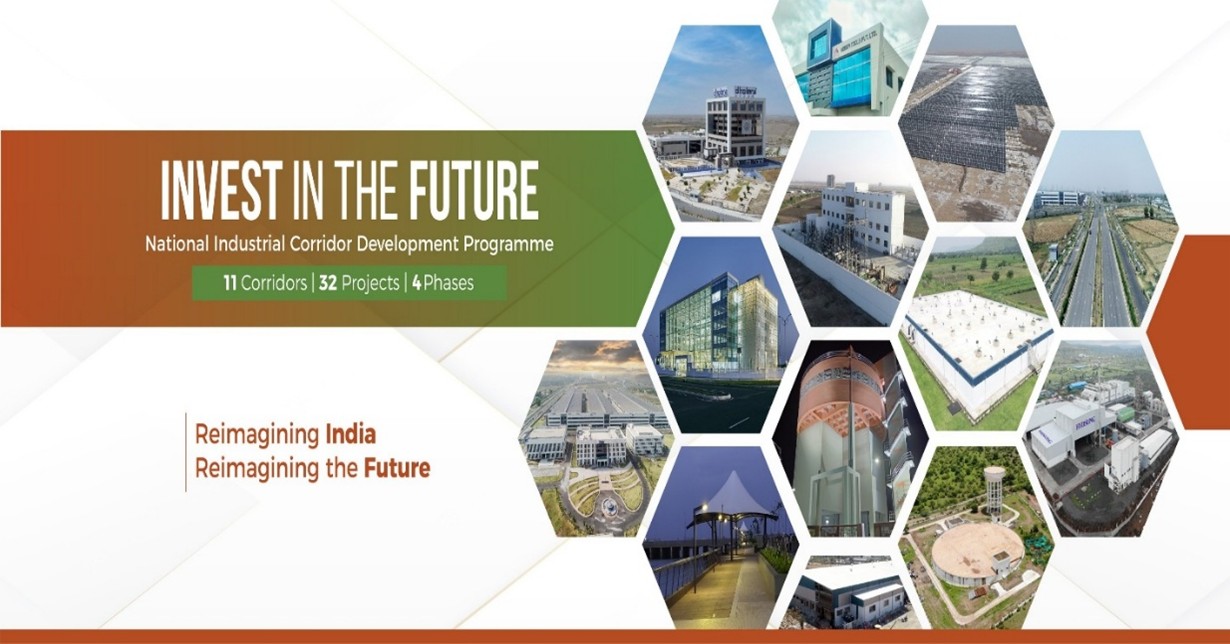
Ministry or Nodal Agency:
- Ministry of Commerce & Industry.
- The Department for Promotion of Industry and Internal Trade (DPIIT) under the Ministry of Commerce & Industry oversees the programme.
- NICDC Ltd. Establishment: The National Industrial Corridor Development Corporation (NICDC) Ltd. has been established as a Special Purpose Vehicle (SPV).
- Role: The NICDC Ltd. is responsible for coordinating the implementation of the National Industrial Corridor Development Programme (NICDP).
- Purpose: The SPV aims to manage and oversee the development of the industrial corridors across India.
Objectives:
- Industrial Growth: Accelerate the development of industrial corridors across the country, fostering manufacturing, economic growth, and urbanisation.
- Sustainable Development: Focus on the creation of smart cities and industrial hubs incorporating modern, sustainable infrastructure and green technologies.
- Job Creation: Generate direct and indirect employment, contributing to regional and national socio-economic upliftment.
- Global Competitiveness: Position India as a global leader in manufacturing by attracting investments in key industries and facilitating seamless multi-modal connectivity.
- Regional Development: Promote economic growth in diverse regions by creating industrial nodes and cities with infrastructure tailored to their specific needs.
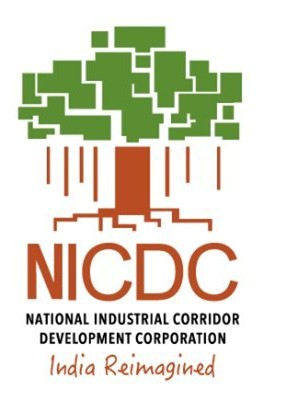
Beneficiaries:
- Manufacturing Units: Domestic and international investors establishing manufacturing units in these corridors.
- Micro, Small, and Medium Enterprises (MSMEs): Encouraged to establish their operations in these industrial hubs.
- State Governments: Benefit from infrastructure development, investment opportunities, and economic growth in their regions.
- General Public: Communities around these corridors will benefit from job creation, improved living standards, and infrastructural developments.
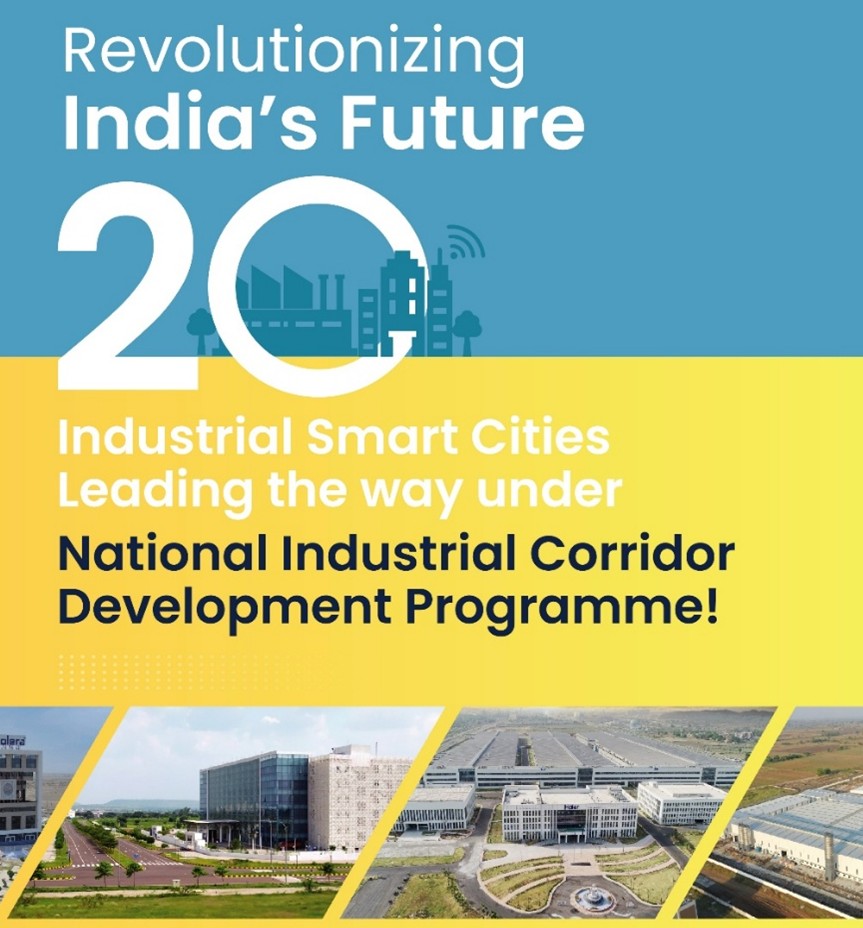
Eligibility Criteria:
- Open to all industrial sectors but focuses primarily on manufacturing industries like Defence, Aviation, Pharmaceuticals, High-Tech, and Engineering.
- Both domestic and international investors are eligible to invest in the industrial zones.
- Specific eligibility criteria for investors are tied to individual corridor guidelines and the availability of land and infrastructure.
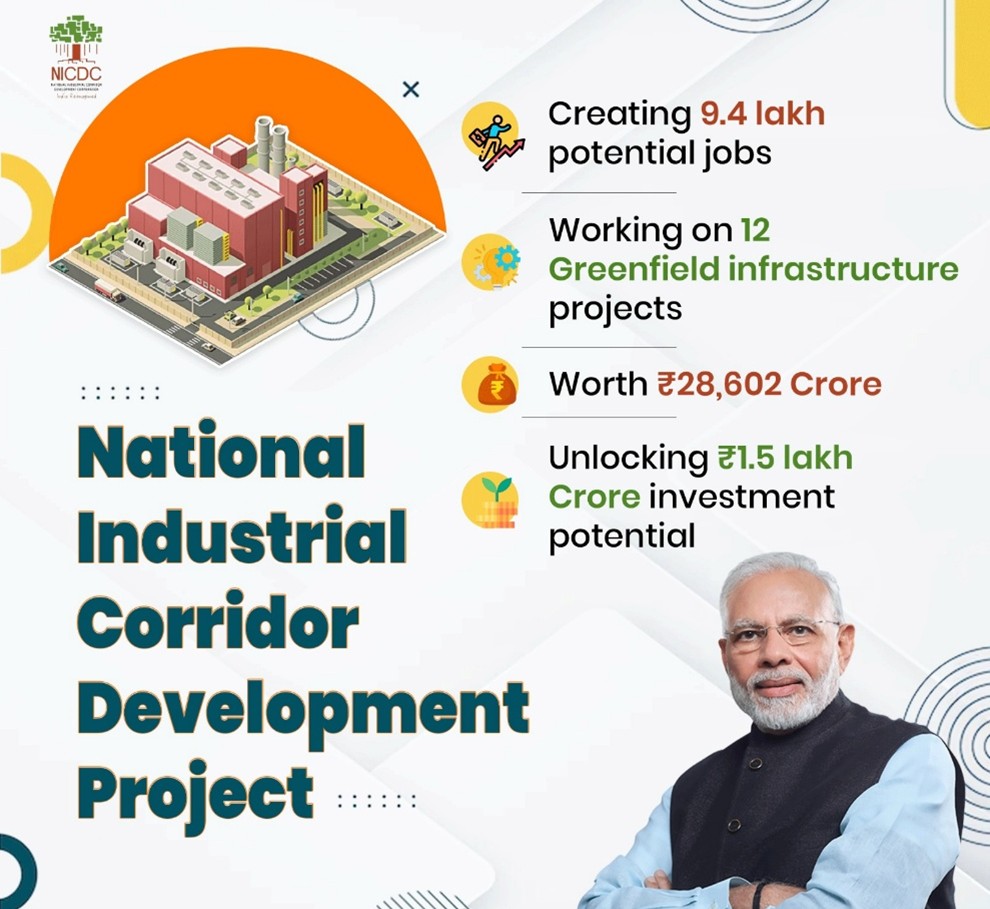
Benefits:
Developed Greenfield Industrial Smart Cities
Dholera Special Investment Region, Gujarat
- Established in 2016.
- Located 100 km southwest of Ahmedabad, Dholera is India's first platinum-rated industrial smart city.
- Key Sectors: Defence, Aviation, High-Tech, Pharmaceuticals.
- The largest in Southeast Asia.
- Focuses on sustainable, non-polluting industries to drive regional and national growth.
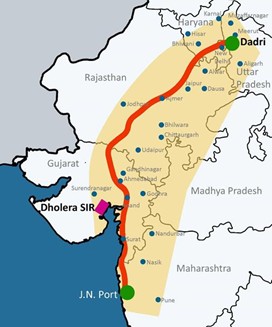
Aurangabad Industrial Township Limited, Maharashtra
- A greenfield smart industrial city covering 10,000 acres in Maharashtra.
- Located near Aurangabad at Shendra and Bidkin.
- Developed under the Delhi-Mumbai Industrial Corridor (DMIC) initiative.
- Managed by Aurangabad Industrial Township Limited (AITL), a Special Purpose Vehicle (SPV) formed between MIDC and NICDC Trust.
Integrated Industrial Township, Greater Noida (Uttar Pradesh)
- Designed to create a robust industrial ecosystem in Greater Noida.
- Integrated Industrial Township, Vikram Udyogpuri (Madhya Pradesh)
- Located in Narwar village, 8 km from Ujjain and 12 km from Dewas.
- The project spans 442.3 hectares (1,096 acres).
- Designed to boost employment, industrial output, and regional exports.
- Features trunk infrastructure and supporting social and physical amenities.
- Strategically located along State Highway 18 within the DMIC region.
Integrated Industrial Township, Vikram Udyogpuri (Madhya Pradesh)
- Located in Narwar village, 8 km from Ujjain and 12 km from Dewas.
- The project spans 442.3 hectares (1,096 acres).
- Designed to boost employment, industrial output, and regional exports.
- Features trunk infrastructure and supporting social and physical amenities.
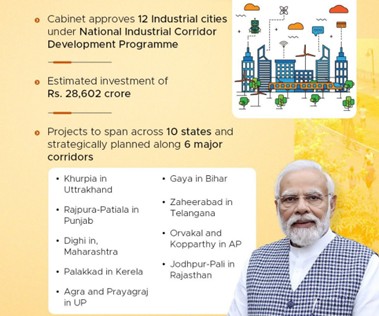
Additional Information
- Completed Projects: NICDP has already completed four projects, with four more currently under implementation.
- Strategic Focus: The focus of these projects is on creating integrated development, sustainable infrastructure, and ensuring seamless connectivity.
- Global Competitiveness: These initiatives are aimed at positioning India as a global manufacturing powerhouse and driving the nation's economic growth for years to come.
- Corridor Locations: NICDP includes multiple corridors and industrial nodes across India, such as:
- Dholera (Gujarat)
- Aurangabad (Maharashtra)
- Greater Noida (Uttar Pradesh)
- Vikram Udyogpuri (Madhya Pradesh)
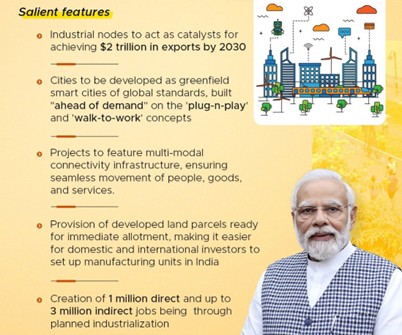
Government Approval for Industrial Corridors
- The Government of India has granted approval for the development of 11 industrial corridors comprising 32 projects, organized into four phases.
The approved industrial corridors are:
- Delhi-Mumbai Industrial Corridor (DMIC)
- Chennai-Bengaluru Industrial Corridor (CBIC)
- Extension of CBIC to Kochi via Coimbatore
- Amritsar-Kolkata Industrial Corridor (AKIC)
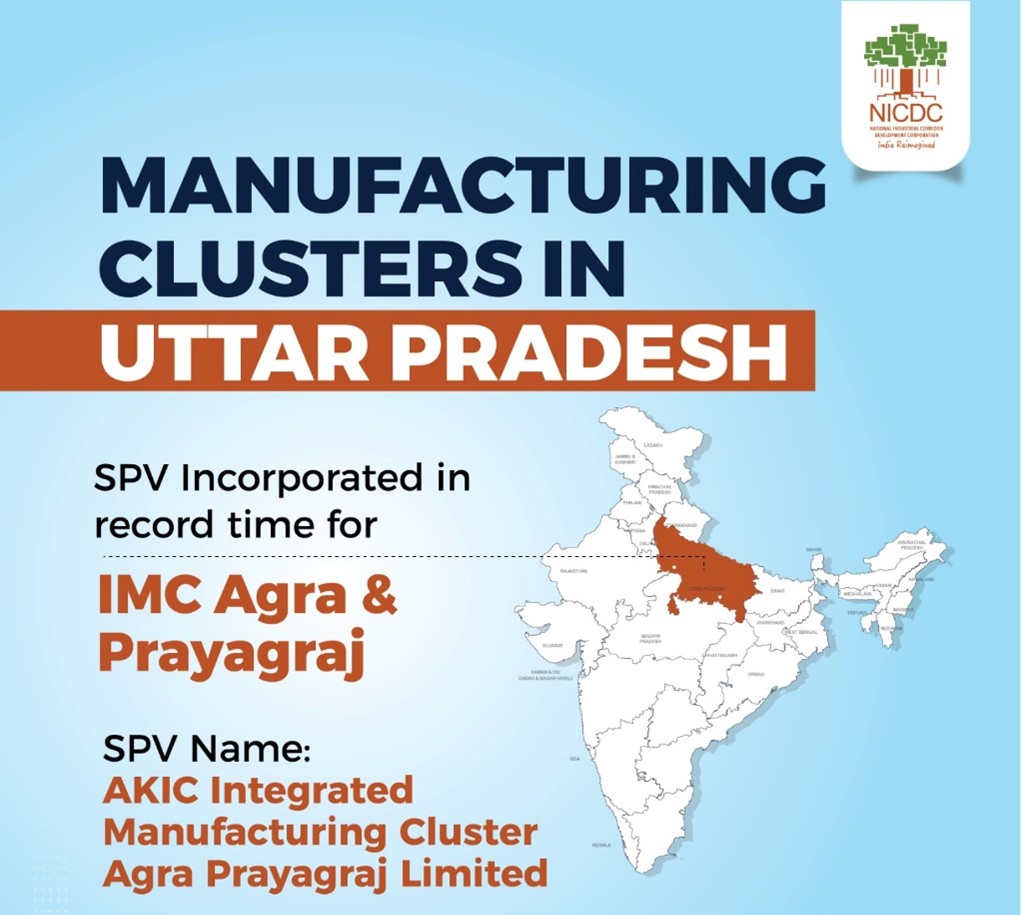
- Hyderabad-Nagpur Industrial Corridor (HNIC)
- Hyderabad-Warangal Industrial Corridor (HWIC)
- Hyderabad-Bengaluru Industrial Corridor (HBIC)
- Bengaluru-Mumbai Industrial Corridor (BMIC)
- East Coast Economic Corridor (ECEC) with Vizag-Chennai Industrial Corridor (VCIC) as Phase-1
- Odisha Economic Corridor (OEC)
- Delhi-Nagpur Industrial Corridor (DNIC).
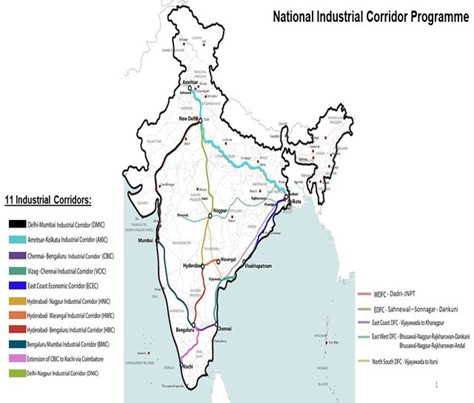
Cabinet Approval of 12 New Industrial Nodes/Cities
- Cabinet Committee on Economic Affairs Approval: The Cabinet Committee on Economic Affairs has approved the establishment of 12 new industrial nodes.
- Objective: The goal is to create a strong network of industrial hubs across India to drive economic growth.
- Investment: The estimated investment for the development of these 12 cities is ₹28,602 crore.
- Impact: The initiative is expected to enhance India’s global competitiveness and significantly contribute to the nation's industrial transformation.
- Enhanced Global Competitiveness: The project is designed to improve India’s competitiveness in the global market.
- Strategic Development: These industrial hubs will play a crucial role in strengthening India's industrial infrastructure and fostering long-term sustainable development.
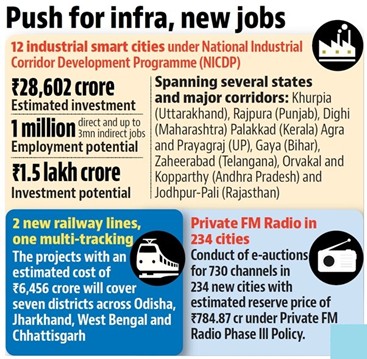
The approved cities are:
- Khurpia, Uttarakhand
- Rajpura-Patiala, Punjab
- Dighi, Maharashtra
- Palakkad, Kerala
- Agra, Uttar Pradesh
- Prayagraj, Uttar Pradesh
- Gaya, Bihar
- Zaheerabad, Telangana
- Orvakal, Andhra Pradesh
- Kopparthy, Andhra Pradesh
- Jodhpur-Pali, Rajasthan.
- These projects, planned along six major corridors.
National Logistics Policy (NLP)
Launched Year:
- 17th September 2022.
Ministry or Nodal Agency:
- Ministry of Commerce and Industry (DPIIT).
Objectives:
- To drive economic growth and enhance business competitiveness by creating an integrated, seamless, efficient, reliable, green, sustainable, and cost-effective logistics network.
- To reduce logistics costs and improve performance by leveraging advanced technology, processes, and skilled manpower.
- To reduce logistics cost in India.
- To improve India’s Logistics Performance Index (LPI) ranking, with a target to be among the top 25 countries by 2030.
- To create a data-driven decision support mechanism for an efficient logistics ecosystem.
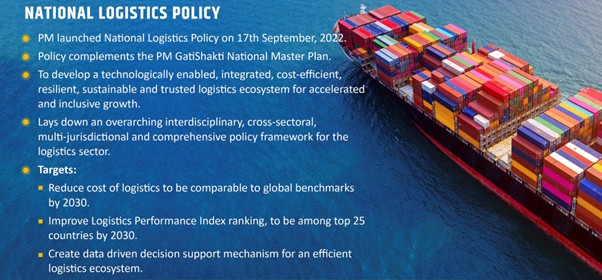
Beneficiaries:
- Businesses involved in logistics, manufacturing, trade, and transportation.
- Industries and logistics service providers.
- State and Union Territories (UTs) in India.
- Stakeholders in the logistics and supply chain sector.

Eligibility Criteria:
- All stakeholders in the logistics, transportation, and supply chain industries, including state and central government entities, private players, and public sectors.
Benefits:
- Reduction in logistics costs and improvement in logistics performance.
- Creation of a seamless and efficient logistics network.
- Integration of logistics systems, improvement in service quality, and capacity building.
- Streamlining of EXIM logistics and port connectivity to reduce supply chain wastage.
- Improvement in the overall logistics ecosystem through data-driven decision-making.
- Development of skilled manpower and enhancement of human resource capabilities in logistics.
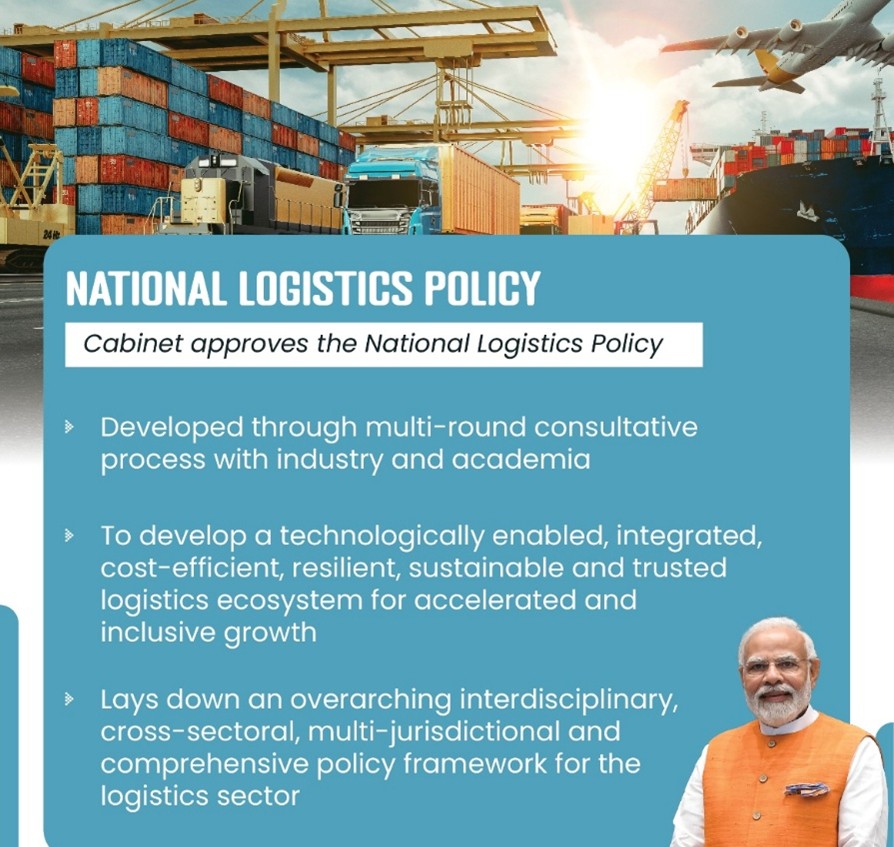
Additional Information:
- PM Gati Shakti & NLP: The National Logistics Policy (NLP) works alongside the PM Gati Shakti National Master Plan (NMP) by focusing on improving logistics services, digitization, process reforms, and skill development.
- Comprehensive Logistics Action Plan (CLAP): Launched as part of the NLP, it covers key areas like digital logistics systems, asset standardization, human resource development, EXIM logistics, and logistics park development.
- Unified Logistics Interface Platform (ULIP): A key achievement of NLP, ULIP integrates 34 logistics-related systems from different government departments and ministries, with over 600 industry players involved.
- EXIM Logistics: Prioritizing trade facilitation, NLP addresses infrastructure gaps and enhances port connectivity, using tools like the Logistics Data Bank (LDB) to improve cargo tracking and reduce supply chain wastage.
- State Logistics Policy: 22 states have developed their own logistics plans, aligning with the National Logistics Policy, to improve logistics at the state level.
- Logistics Ease Across Different States (LEADS): This index ranks states based on logistics performance, helping identify areas for improvement.
- Logistics Cost Framework: A framework is being created to estimate logistics costs, starting with baseline data and moving towards more accurate, long-term estimates.
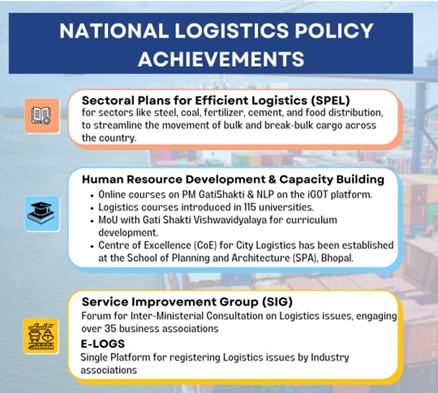
-------------------------------------


